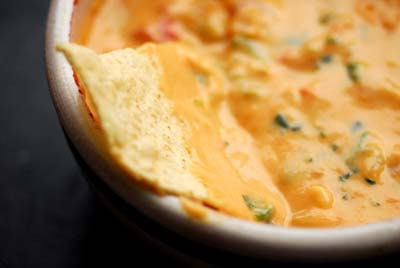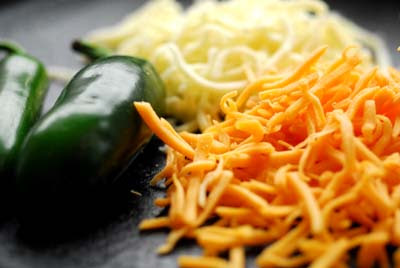 If I share a secret with you, do you promise not to laugh? I like Velveeta. I know, I know—that stuff isn’t even a proper dairy product. Instead it’s a cheese food that can sit on the shelf (no refrigeration necessary) for years on end. But in Texas we have a special place in our hearts for Velveeta, especially when it’s melted with a can of Rotel. We call that concoction chile con queso, or just queso for short.
If I share a secret with you, do you promise not to laugh? I like Velveeta. I know, I know—that stuff isn’t even a proper dairy product. Instead it’s a cheese food that can sit on the shelf (no refrigeration necessary) for years on end. But in Texas we have a special place in our hearts for Velveeta, especially when it’s melted with a can of Rotel. We call that concoction chile con queso, or just queso for short.Chile con queso, which translates to peppers with cheese, is pronounced “kay-so.” And I admit, as trashy and processed as cheese food is, in its melted state it is good stuff—a party standard that can’t be beat. But when you go to a restaurant and order queso, you would hope for something a tad more sophisticated. And sure, many places serve something they call queso compuesto, which is a fancy way of saying “queso and other good things"—good things being a scoop of guacamole thrown into the bowl, or some beans or fajita meat also added to the dip. Restaurant queso, however, is often still made from processed cheese. It may be a higher quality, restaurant-grade of processed cheese, but nonetheless it’s still a rectangular brick of cheese food. Don’t get me wrong, I love the stuff, and can eat buckets of it. But I was curious if it was possible to make queso with real cheese and still have it taste like its processed-cheese brethren.
 I decided to start my queso quest by doing a bit of research on the history of chile con queso. In its yellow, molten state it’s a truly Tex-Mex creation, but there is a proper Mexican counterpart also known as chile con queso that is made with white Mexican cheese. Most often found in the northern states of Chihuahua and Sonora, this version is made with fresh poblanos or Anaheim chiles that are roasted and cut into strips. These roasted chiles, also known as rajas, join tomatoes and onions in a warm sauce made from milk and Mexican cheese, such as asadero. Instead of chips, it’s served with warm tortillas.
I decided to start my queso quest by doing a bit of research on the history of chile con queso. In its yellow, molten state it’s a truly Tex-Mex creation, but there is a proper Mexican counterpart also known as chile con queso that is made with white Mexican cheese. Most often found in the northern states of Chihuahua and Sonora, this version is made with fresh poblanos or Anaheim chiles that are roasted and cut into strips. These roasted chiles, also known as rajas, join tomatoes and onions in a warm sauce made from milk and Mexican cheese, such as asadero. Instead of chips, it’s served with warm tortillas.Read more »

Comments
Post a Comment